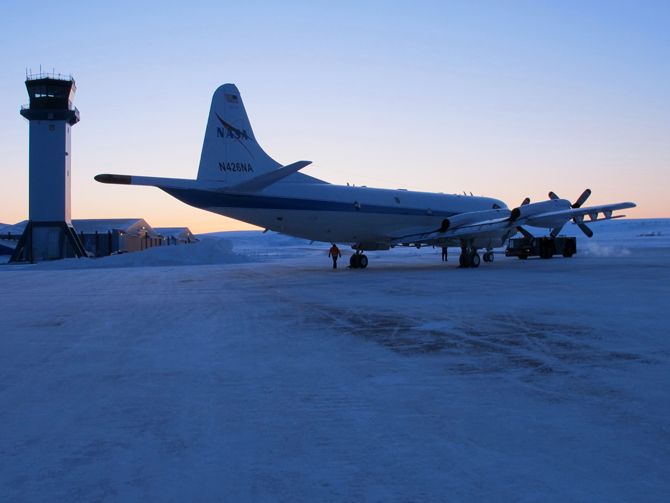NASA's IceBridge Readies 1st Antarctica-Based Research Flights

In a few weeks, NASA's Operation IceBridge will take to the skies for another busy season of monitoring ice sheets, glaciers and sea ice from above. This year, the mission will be stationed in Antarctica for the first time, enabling scientists to conduct longer flights, and explore areas of the icy continent that were previously out of reach.
NASA's modified P-3B aircraft is scheduled to depart NASA's Wallops Flight Facility in Wallops Island, Va., on Nov. 11, and touch down at McMurdo Station in Antarctica later that week, Christy Hansen, IceBridge project manager at NASA's Goddard Space Flight Center in Greenbelt, Md., told reporters in a news briefing today (Oct. 29).
Previously, Operation IceBridge research flights took off from Punta Arenas in southern Chile, but this season, the mission will operate directly out of Antarctica. [Images: NASA's IceBridge in Action Over Antarctica ]
"Once we start getting into science data collection, we'll be able to collect more science data than when we were based in Chile," Hansen said.
Being stationed in Antarctica will also allow researchers to plan science flights that last up to eight hours, which means the aircraft will be able to cover more ground — in some cases, enabling scientists to survey parts of Antarctica not visited on previous IceBridge missions.
Operation IceBridge was one of several Antarctic missions threatened by the recent shutdown of the U.S. federal government, which lasted from Oct. 1 through Oct. 16. During that time, about 800,000 federal employees were furloughed, including Michael Studinger, IceBridge's lead scientist at the Goddard Space Flight Center.
As a result, the status of the IceBridge mission was in limbo for some time, and despite weathering the political storm, Studinger said the government shutdown is expected to limit the amount of research that will be conducted this season.
Sign up for the Live Science daily newsletter now
Get the world’s most fascinating discoveries delivered straight to your inbox.
"It put our preparations on hold for more than two weeks, and added some other headaches that we had to resolve," Studinger said. "We'll collect considerably less science data than we had planned for."
Chad Naughton, project manager for the National Science Foundation's (NSF) U.S. Antarctic Program in Centennial, Colo., said overcoming the effects of the shutdown was challenging, but he expects federally funded research in Antarctica to bounce back.
"We're all systems go for a lot of the good science that's coming down," Naughton said. "It seems annually there's always something that pops up that's a challenge … that affects a lot of science and a lot of the logistics. This was a big one, but I think we got through it, and I think a lot of the science that NSF funds on an annual basis is going to continue."
Operation IceBridge is a six-year campaign to study how glaciers, sea ice and ice sheets at both poles change over time. The P-3B aircraft is outfitted with a suite of instruments that measure changes in ice elevation and thickness, and probe the shape of bedrock and water cavities beneath the continent's icy armor.
"The main purpose is to measure the change in ice surface elevation over time — from year to year," Studinger said. "And this allows us to estimate how much ice an ice sheet is gaining or losing, [which is] important because we want to understand how much this melting ice is contributing to sea level rise."
NASA's IceBridge mission is designed to provide critical measurements to bridge the gap between the defunct ICESat satellite and the planned ICESat-2, which is scheduled to launch in 2016.
In 2011, IceBridge scientists discovered a huge crack in the Pine Island Glacier's floating ice shelf. Earlier this year, the ice shelf calved, dropping an iceberg larger than the city of Chicago into the Amundsen Sea.
Follow Denise Chow on Twitter @denisechow. Follow LiveScience @livescience, Facebook & Google+. Original article on LiveScience.

Denise Chow was the assistant managing editor at Live Science before moving to NBC News as a science reporter, where she focuses on general science and climate change. Before joining the Live Science team in 2013, she spent two years as a staff writer for Space.com, writing about rocket launches and covering NASA's final three space shuttle missions. A Canadian transplant, Denise has a bachelor's degree from the University of Toronto, and a master's degree in journalism from New York University.












